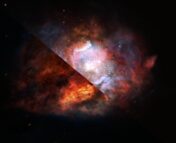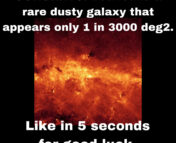Paper Title: Central concentration of warm and dense molecular gas in a strongly lensed submillimeter galaxy at z=6
Authors: Akiyoshi Tsujita , Ken-ichi Tadaki, Kotaro Kohno, Bunyo Hatsukade, Fumi Egusa, Yoichi Tamura, Yuri Nishimura, Jorge Zavala, Toshiki Saito, Hideki Umehata and Minju M. Lee
First Author’s Institution: Institute of Astronomy, The University of Tokyo, Japan
Status: Accepted in PASJ [closed access]
The story of the distant, dusty star-forming galaxy (DSFG) starts with a big inflow of gas, the fuel for its intense burst of star formation. DSFGs are massive galaxies cloaked in dust produced during their extreme starburst phase, which is thought to end with an eventual decline into quiescence (like the galaxies in this Astrobite), when their star formation activity shuts off nearly completely. New discoveries of these massive quiescent galaxies very early on are adding some pressure to this picture, as the existence of quiescent galaxies at high redshift (or early times) requires that a ton of mass be built up via huge starbursts impossibly early in the Universe. In other words, we need extreme, dusty ancestors of quiescent galaxies to somehow grow quickly then quench rapidly, just as the Universe got going, which pushes our current understanding of galaxy evolutionary models.
To better understand what’s going on in this extreme scenario, the authors of today’s paper took a deep dive into the stuff within one of these very distant DSFGs. In this case the “stuff” of interest is the galaxy’s molecular gas and dust content, altogether called the interstellar medium (ISM). Their target galaxy is G09-83808, which exists as a DSFG at redshift z ~ 6 (less than a billion years after the Big Bang) that could evolve into a quiescent galaxy at z ~ 4 (1.5 billion years after the Big Bang), and has two notable advantages as an ISM case study. First, while it is a fairly bright galaxy, compared to the handful of other known DSFGs at early times (or, at high redshifts z>5), it is slightly fainter and therefore more typical. Second, G09-83808 is gravitationally lensed by a galaxy in front of it along the observer’s line of sight that distorts and magnifies its light before it reaches the observer, turning the Universe into a sort of cosmic house of mirrors and making it easier to study the galaxy in detail.
Full of hot gas
Though the fuel for star formation – molecular gas – is predominantly molecular hydrogen (H2), it is difficult to detect directly as their emission lines, the light signatures of elements and molecules, are very weak. Although carbon monoxide (CO) is less abundant than H2, it is easier to detect and has much stronger emission lines, making it a good tracer of total molecular gas. Observing multiple rotational transitions via multiple emission lines of CO can enable measurements of physical quantities of the molecular gas such as the temperature, density, and mass. From there, the state of multiple components (or phases) of the ISM can be quantified.
In today’s paper, the authors analyze this tracer among a collection of detections of their target galaxy using the Atacama Large Millimeter/submillimeter Array (ALMA). A previous paper from the team presented detections of doubly ionized Oxygen, ionized Nitrogen, and dust at multiple wavelengths. Combined with today’s paper on a high energy CO line, specifically CO(12-11), the authors measured an assortment of properties of the galaxy’s ISM.
High energy CO lines trace warm, dense gas, so the mere detection of CO(12-11) implies the presence of highly excited gas in the galaxy. After modeling the lensing to disentangle the warping effect and reconstruct the original image of the galaxy, they plotted the sizes and positions of their assortment of detections (see Figure 1). They measured the size (radius) of CO(12-11) emission to be compact at ~0.5 kpc (our home Milky Way Galaxy is about 30 kpc across), which they found to be consistent with the size of emission from dust but twice as small as the oxygen and nitrogen emission, though they were all at consistent positions within the galaxy. This makes sense, as CO emission tends to be contained within a smaller region for a higher excitation level, and less excited emission in these types of galaxies is often more extended than the dust.
With a handful of lower energy CO lines in their assortment, the authors did a quantitative investigation of the gas properties with radiative transfer modeling, the physical understanding of how light travels and emits through a medium. Their modeling reveals a two component fit is necessary, meaning the galaxy has both cool gas and warm gas components. Based on this analysis, they find most of the CO(12-11) emission originates from the warm gas component. Together with the compact extent of CO(12-11) emission, this suggests the highly excited emission originates from a central concentration of gas.
The source of excitement
Taking a step back, how do these starbursts get triggered in the first place? In a basic sense, they need a big shipment of gas to arrive either by another galaxy smashing into it or a cold stream from the cosmic web. In the cold streams case, starbursts are caused by giant star forming clumps that migrate into the center of the galaxy, and feed a large gas rich disk-shaped galaxy with central star formation. Then, this central starburst would build a bulge, much like what we see in compact quiescent galaxies shortly thereafter. The authors suggest this may be the case for G09-83808.
One additional detail came out of the models regarding the heating source for the excited, concentrated gas. As we know, detecting CO(12-11) at all implies there is a high energy source of heat in the galaxy. Yet, the detection was strong enough that the authors propose the bright CO(12-11) line cannot be fully explained by a starburst alone, and potentially implies another type of temporary mega-bright phase is also contributing energy. The other usual culprit is an active galactic nucleus, or AGN, where a galaxy’s central supermassive black hole (SMBH) vigorously funnels in material and creates a disk of hot, luminous gas and dust around it. Comparing their ISM results to other known starbursts and AGN, the authors find more consistency with the AGN sample. Paired with the known dustiness of the galaxy, they propose that their galaxy is a dust-obscured AGN, although more data is needed to determine this definitively, and provide more clues as to the reign and demise of early DSFGs.
Astrobite edited by Maryum Sayeed
Featured image credit: NASA via Getty Images (galaxy) & iStock (scientists)




